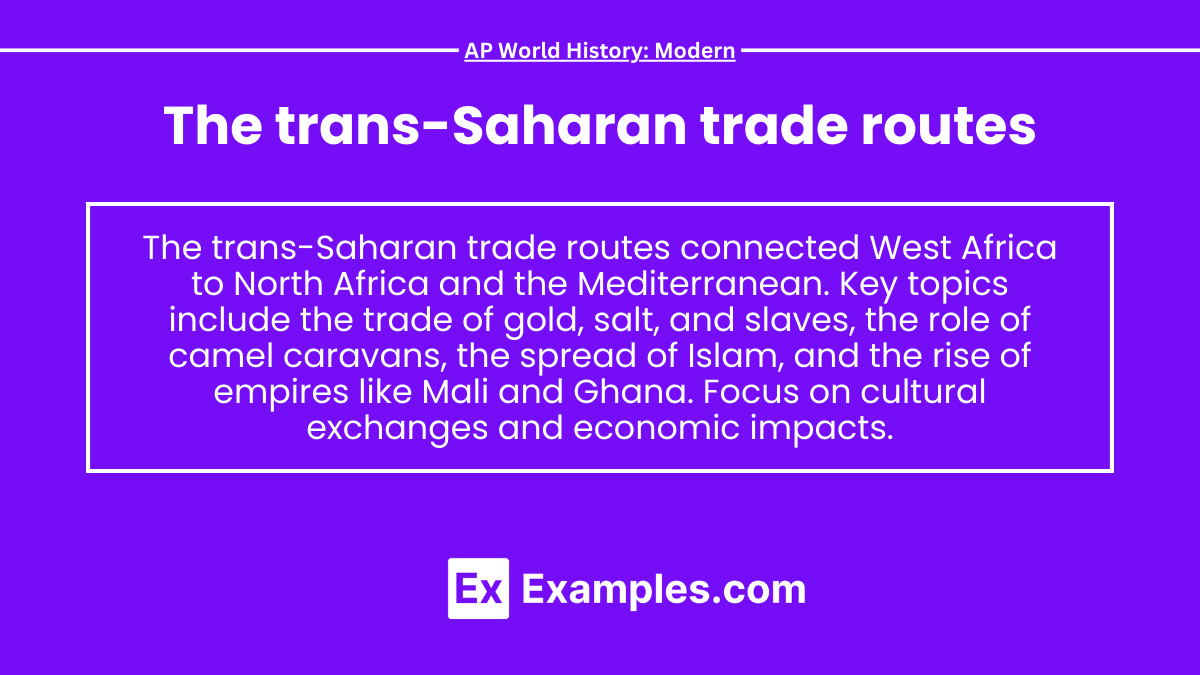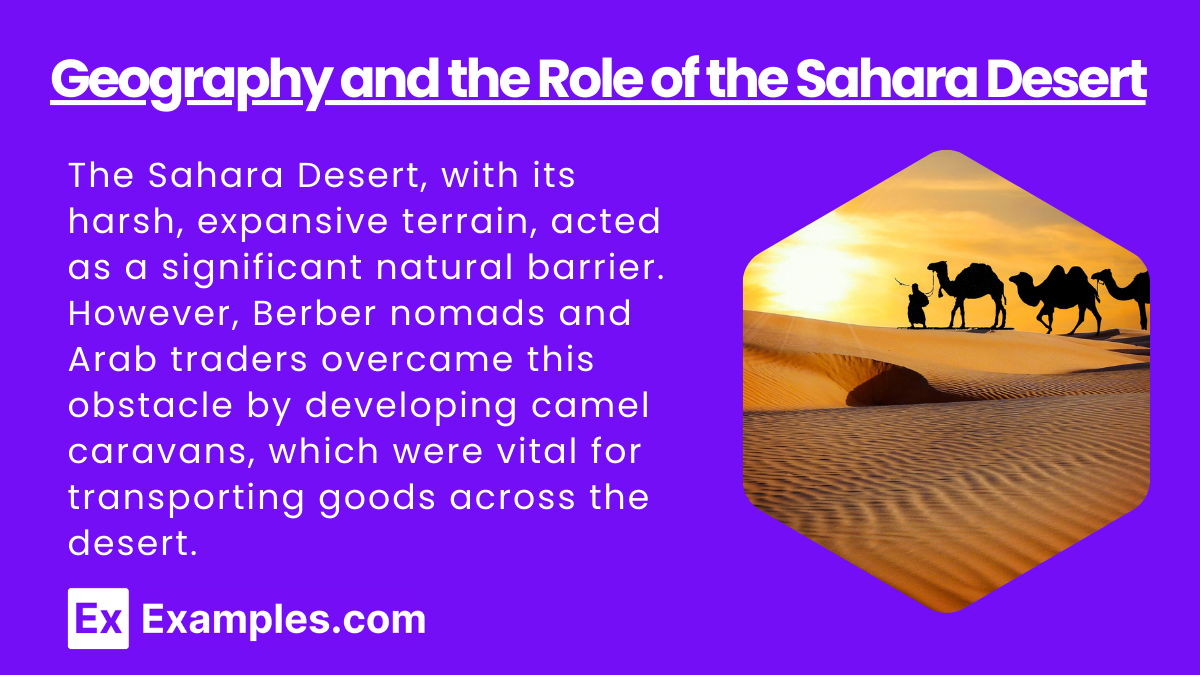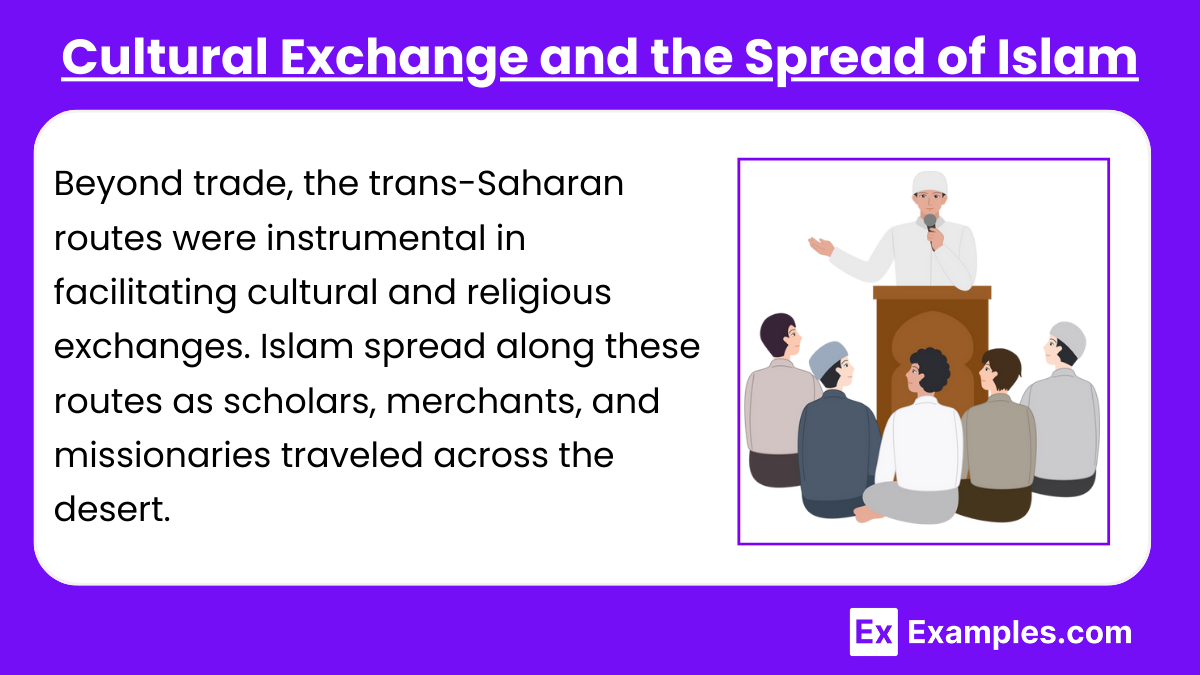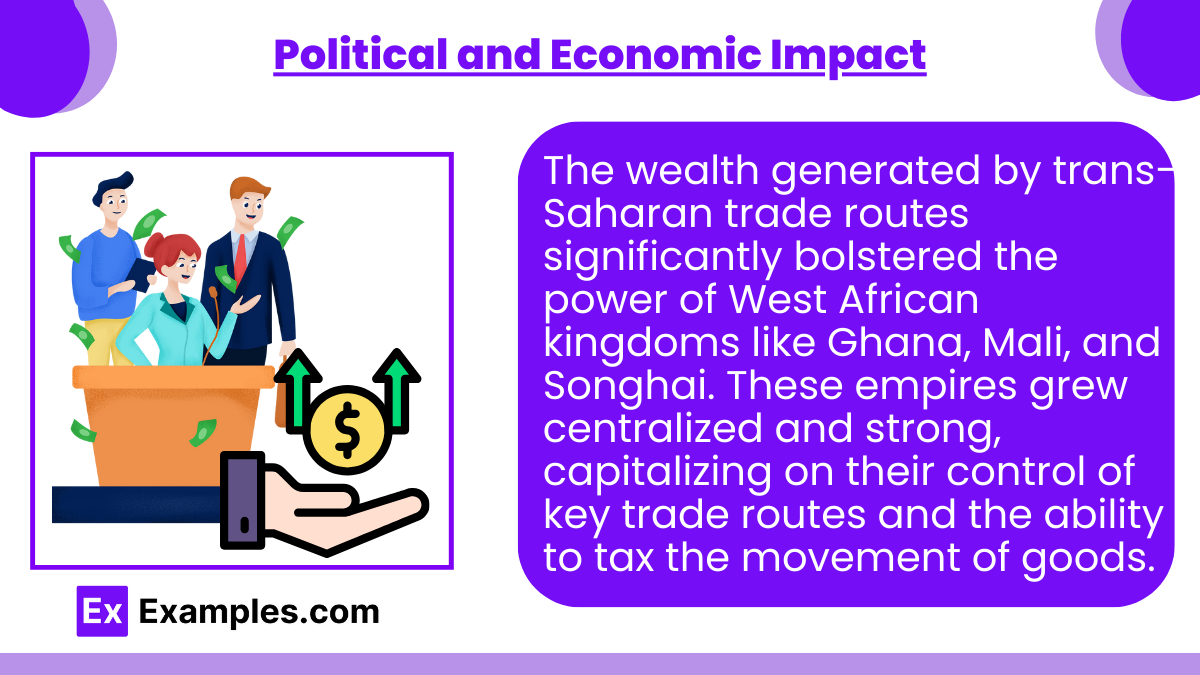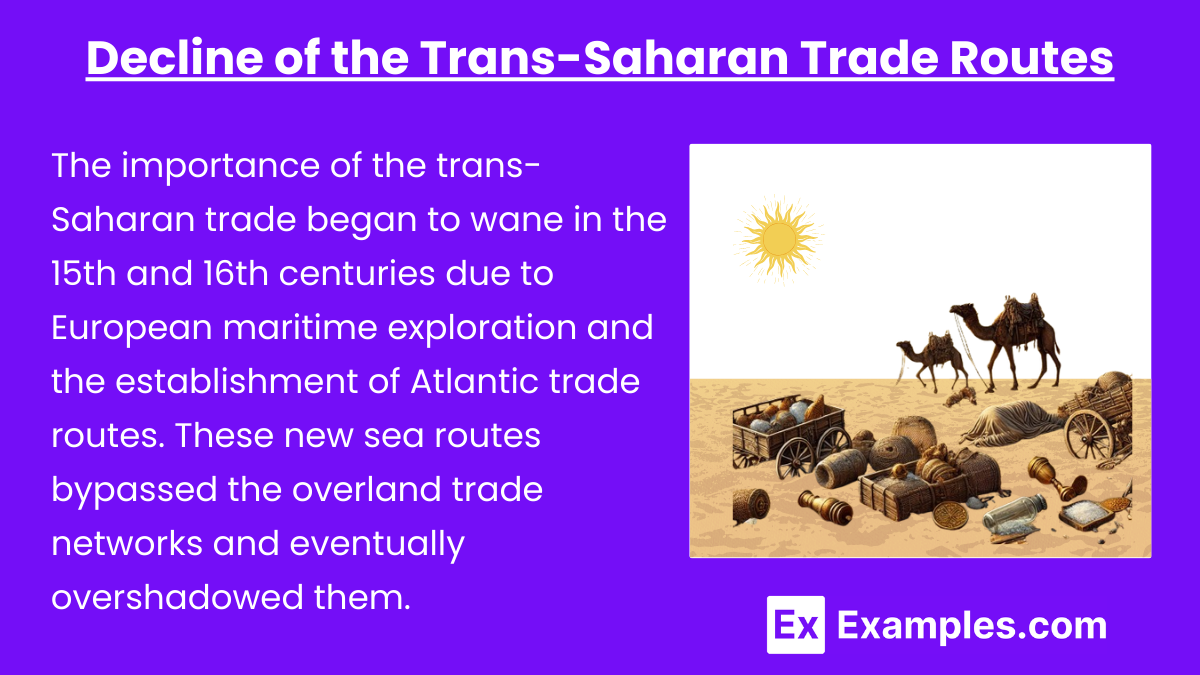The trans-Saharan trade routes, active between the 8th and 16th centuries, connected West Africa with North Africa and the Mediterranean world. These routes facilitated the exchange of gold, salt, ivory, and slaves, while also promoting cultural and religious exchanges, particularly the spread of Islam. The trade helped build powerful West African empires like Ghana, Mali, and Songhai.
Free AP World History: Modern Practice Test
Learning Objective
In studying "The Trans-Saharan Trade Routes" for AP World History: Modern, you should learn to identify the key goods traded, such as gold, salt, and slaves, and the major regions involved, including West Africa and North Africa. Analyze the role of camel caravans and innovations in transportation that made this trade possible across the desert. Evaluate the social, political, and economic impact of the trade on the rise of powerful West African kingdoms, such as Mali and Ghana, and examine how the exchange of goods, ideas, and religion, particularly Islam, shaped the cultural and economic landscape of the region.
1. Geography and the Role of the Sahara Desert
The Sahara Desert, with its harsh, expansive terrain, acted as a significant natural barrier. However, Berber nomads and Arab traders overcame this obstacle by developing camel caravans, which were vital for transporting goods across the desert. Camels, referred to as the "ships of the desert," were particularly well-suited to this environment, capable of carrying heavy loads over long distances due to their endurance and ability to survive in arid conditions.
2. Key Trade Goods:
Gold and Salt: The kingdoms of West Africa—such as Ghana, Mali, and Songhai—were known for their abundant gold resources, which were highly sought after in North Africa and Europe. In return, salt, an essential commodity mined from the Sahara, was brought south. Salt was crucial for food preservation and human consumption, making it just as valuable as gold in many regions.
Ivory, Slaves, and Manufactured Goods: Alongside gold and salt, West African traders exported ivory and slaves. In exchange, they imported manufactured goods, textiles, and luxury items from North Africa and the Mediterranean. These exchanges enriched both regions, creating wealth and fostering stronger political connections.
3. Cultural Exchange and the Spread of Islam
Beyond trade, the trans-Saharan routes were instrumental in facilitating cultural and religious exchanges. Islam spread along these routes as scholars, merchants, and missionaries traveled across the desert. The establishment of Islamic states in West Africa led to the development of prominent centers of learning, such as Timbuktu, Gao, and Djenne. Islam deeply influenced the governance, legal systems, education, and culture of these regions, with Islamic beliefs becoming integral to West African societies.
4. Political and Economic Impact
The wealth generated by trans-Saharan trade routes significantly bolstered the power of West African kingdoms like Ghana, Mali, and Songhai. These empires grew centralized and strong, capitalizing on their control of key trade routes and the ability to tax the movement of goods. Notable figures, such as Mansa Musa of Mali, became legendary for their wealth, much of which was derived from this flourishing trade. The wealth and influence of these kingdoms not only enhanced their political power but also their cultural development.
5. Decline of the Trans-Saharan Trade Routes
The importance of the trans-Saharan trade began to wane in the 15th and 16th centuries due to European maritime exploration and the establishment of Atlantic trade routes. These new sea routes bypassed the overland trade networks and eventually overshadowed them. As European powers began to dominate global trade, the significance of the trans-Saharan routes diminished, leading to the decline of the once-thriving trade that had connected Africa with the Mediterranean and Europe for centuries.
Examples
Example 1: Gold and Salt Trade Between Ghana and Sijilmasa
The Kingdom of Ghana, located in West Africa, was a major hub for the export of gold, which was highly sought after by North African traders. Gold was transported across the Sahara to cities like Sijilmasa in modern-day Morocco, where it was traded for salt, a valuable resource mined in the Sahara desert.
Example 2: Mansa Musa’s Pilgrimage to Mecca
In 1324, Mansa Musa, the ruler of the Mali Empire, undertook a famous pilgrimage to Mecca. He traveled with a massive caravan of camels loaded with gold, slaves, and goods through the trans-Saharan trade routes, demonstrating the wealth and power of Mali. His journey helped spread the reputation of Mali’s riches and fostered further trade connections.
Example 3: Timbuktu as a Major Trade and Cultural Center
Located in the Mali Empire, Timbuktu became a key trading city on the trans-Saharan routes. It served as a crossroads for traders from North Africa and sub-Saharan Africa, dealing in gold, salt, ivory, and slaves. The city also emerged as an intellectual hub, known for its Islamic learning centers and libraries.
Example 4: The Role of Taghaza in the Salt Trade
Taghaza, an oasis town in the Sahara desert, became an important center for salt production. The town’s mines provided a crucial supply of salt, which was transported south across the desert to trade with West African kingdoms for gold and other goods. Salt from Taghaza was vital for the preservation of food in West Africa.
Example 5: Decline of Gao and Its Impact on Trade
Gao, a city in the Songhai Empire, was a major terminus of the trans-Saharan trade routes. It prospered as a key point for the exchange of goods between the West African interior and the Mediterranean world. However, the Moroccan invasion of Songhai in 1591 weakened the city’s control over the trade routes, contributing to the eventual decline of trans-Saharan commerce.
MCQs
Question 1:
Which of the following commodities was most commonly traded from West Africa across the trans-Saharan trade routes?
A) Spices
B) Gold
C) Silk
D) Silver
Answer: B) Gold
Explanation: Gold was one of the most important commodities exported from West Africa through the trans-Saharan trade routes. West African kingdoms such as Ghana, Mali, and Songhai were rich in gold resources, and this precious metal was highly sought after by traders in North Africa and the Mediterranean. Gold from West Africa was exchanged for salt, textiles, and other goods. The gold trade helped these kingdoms accumulate great wealth and power.
Question 2:
Which animal was crucial in the development and success of the trans-Saharan trade routes?
A) Horse
B) Elephant
C) Camel
D) Donkey
Answer: C) Camel
Explanation: The camel, often referred to as the "ship of the desert," was essential to the success of the trans-Saharan trade routes. Camels were uniquely suited to desert conditions due to their ability to travel long distances without water, endure extreme temperatures, and carry heavy loads. They allowed traders to cross the vast and arid Sahara Desert, linking sub-Saharan Africa with the Mediterranean and North African regions. Without camels, the trans-Saharan trade would not have been possible on such a large scale.
Question 3:
What was the primary reason for the decline of the trans-Saharan trade routes in the 15th and 16th centuries?
A) The rise of European maritime trade routes
B) The collapse of the Roman Empire
C) The discovery of silk-producing regions in Africa
D) A major drought in the Sahara Desert
Answer: A) The rise of European maritime trade routes
Explanation: The decline of the trans-Saharan trade routes in the 15th and 16th centuries was largely due to the rise of European maritime trade routes. European explorers, particularly the Portuguese, began establishing direct sea routes along the West African coast, bypassing the need for overland desert trade. This led to the development of the Atlantic trade network, which became the dominant system for the exchange of goods such as gold, slaves, and other commodities. As a result, the significance of the trans-Saharan trade routes diminished.

